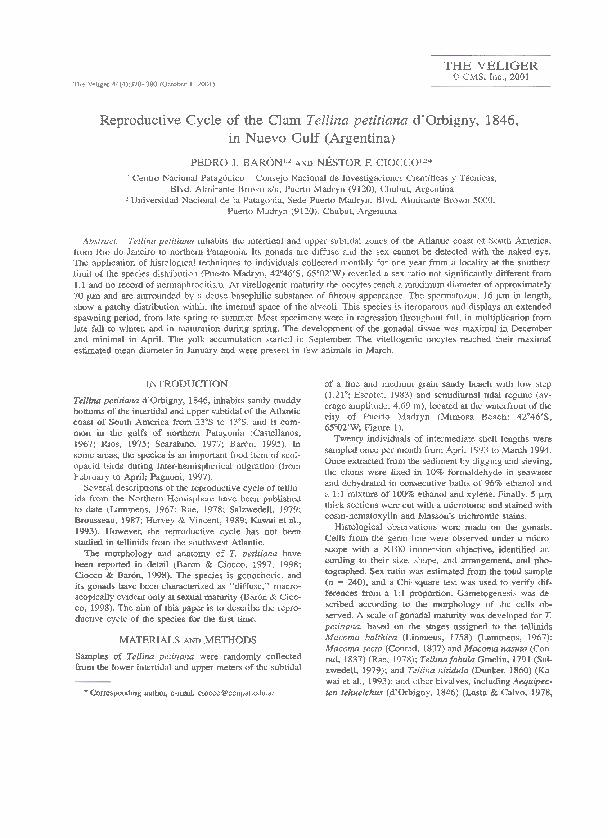Artículo
Reproductive cycle of the clam tellina petitiana d'Orbigny, 1846, in Nuevo Gulf, Argentina
Fecha de publicación:
12/2001
Editorial:
California Malacozoological Society
Revista:
Veliger
ISSN:
0042-3211
Idioma:
Inglés
Tipo de recurso:
Artículo publicado
Clasificación temática:
Resumen
Tellina peririana inhabits the intettidal and upper subtidal zones of the Atlantic coast of South America, from Rio do Janeiro to northern Patagonia. Its gonads are diffuse and the sex cannot be detected with the naked eye. The application of histological techniques to individuals collected monthly for one year from a locality at the southern limit of the species distribution (Puetto Madryn, 4Z046´S, 65-OZ´W) revealed a sex ratio not significantly different from 1:1 and no record of hermaphroditism. At vitellogenic maturity the oocytes reach a maximum diameter of approximately 70 pm and are surrounded by a dense basophilic substance of fibrous appearance. The spermatozoa, 16 pm in length, show a patchy distribution within the internal space of the alveoli. This species is iteroparous and displays an extended spawning period, from late spring to summer. Most specimens were in regression throughout fall, in multiplication from late fall to winter, and in maturation during spring. The development of the gonadal tissue was maximal in December and minimal in April. The yolk accumulation started in September. The vitellogenic wcytes reached their maximal estimated mean diameter in January and were present in few animals in March. inhabits the intettidal and upper subtidal zones of the Atlantic coast of South America, from Rio do Janeiro to northern Patagonia. Its gonads are diffuse and the sex cannot be detected with the naked eye. The application of histological techniques to individuals collected monthly for one year from a locality at the southern limit of the species distribution (Puetto Madryn, 4Z046´S, 65-OZ´W) revealed a sex ratio not significantly different from 1:1 and no record of hermaphroditism. At vitellogenic maturity the oocytes reach a maximum diameter of approximately 70 pm and are surrounded by a dense basophilic substance of fibrous appearance. The spermatozoa, 16 pm in length, show a patchy distribution within the internal space of the alveoli. This species is iteroparous and displays an extended spawning period, from late spring to summer. Most specimens were in regression throughout fall, in multiplication from late fall to winter, and in maturation during spring. The development of the gonadal tissue was maximal in December and minimal in April. The yolk accumulation started in September. The vitellogenic wcytes reached their maximal estimated mean diameter in January and were present in few animals in March.
Palabras clave:
CLAM
,
TELLINA PETITIANA
,
ARGENTINA
,
REPRODUCTIVE CYCLE
Archivos asociados
Licencia
Identificadores
Colecciones
Articulos(IADIZA)
Articulos de INST. ARG DE INVEST. DE LAS ZONAS ARIDAS
Articulos de INST. ARG DE INVEST. DE LAS ZONAS ARIDAS
Citación
Baron, Pedro Jose; Ciocco, Nestor Fernando; Reproductive cycle of the clam tellina petitiana d'Orbigny, 1846, in Nuevo Gulf, Argentina; California Malacozoological Society; Veliger; 44; 4; 12-2001; 370-380
Compartir




